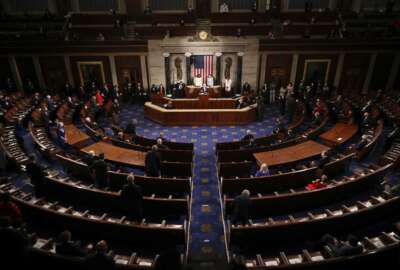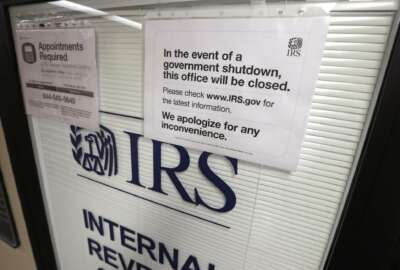
More resources for IRS won’t fix decade of problems ‘overnight’ — but it’s a start
By investing $80 billion in the IRS over the next decade, the White House expects the agency can collect an additional $700 billion over the same period of time.
The Biden administration is looking to rebuild capacity within the IRS to go after tax cheats and answer questions from taxpayers looking to pay what they owe.
By investing $80 billion in the IRS over the next decade, the White House expects the agency can collect an additional $700 billion over the same period of time. The IRS would bring in this additional revenue by shrinking the “tax gap” between what taxpayers owe and what the agency is able to collect each year.
Estimates on the severity of the tax gap vary, but most indicate the gap is growing. The IRS will update its official projection next year, but Commissioner Chuck Rettig recently told the Senate Finance Committee that it “would not be outlandish to believe” that the gap could approach, and possibly exceed” $1 trillion per year, more than double its current estimate.
President Joe Biden, speaking to a joint session of Congress late last month, said his plan would give the agency resources to go after “millionaires and billionaires who cheat on their taxes.”
Five former IRS commissioners, in a Washington Post op-ed earlier this month, supported Biden’s spending plan for the agency, saying the IRS has struggled to process its most complex tax cases with 35% fewer revenue agents who handle this type of work, compared to 10 years ago.
“The scope of the tax compliance problem means that comprehensive proposals to address it would reap substantial benefits,” the commissioners wrote.
But a decade of budget and workforce cuts forced the agency to defer on investments in workforce training and IT modernization. Former IRS officials said it will take time — not just money — for the agency to recover.
Former IRS Commissioner Charles Rossotti, who will testify today before the Senate Finance Committee in a hearing on shrinking the tax gap, released a study last year that found 85% of the current tax gap is concentrated among the top 25% of taxpayers.
Rossotti said in an interview that his projections indicate last year’s tax gap was $574 billion, more than what 135 million individual taxpayers sent the IRS. Aside from collecting revenue left off the table every year, he said shrinking the tax gap restores confidence in taxpayers who pay what they owe every year.
“If you raise taxes, the people that are compliant and are paying are going to pay the new taxes, and the people that are not paying are still not going to be paying, so that didn’t seem very fair. And there’s a lot of money out there,” Rossotti said.
The tax gap has expanded in recent years, he said, mostly because the IRS lacks critical data to monitor business income and doesn’t have the modern IT infrastructure needed to make better use of its data.
Rossotti said giving the IRS greater access to third-party sources of data, such as from banks and other financial institutions, would help the agency collect on taxes owed. The agency, for example, has a high success rate collecting taxes on annual wages because it has the same W-2 data that an individual taxpayer reports.
“The IRS has the same information that you do, so you get accurate reporting,” Rossotti said.
But in the case of business revenue, the IRS doesn’t have as clear a picture of what it’s owed, and in those cases, Rossotti said compliance can be as low as 50%.
Former IRS Commissioner John Koskinen agreed giving the IRS greater access to this third-party data would increase compliance across the board.
“Increasing reporting from banks about what corporations are doing, or from the gig economy — Uber and Lyft drivers, Airbnb renters — will significantly increase compliance just by virtue of the existence of the third-party information, let alone with the addition of revenue agents and officers who can follow through on questionable returns,” Koskinen said.
The key to shrinking the tax gap, Rossotti said, is Congress giving the IRS “steady” increases in funding year-over-year, about 6% annually, to make long-term investments in its workforce and IT.
“The important thing is not only the total amount of money, but how it’s done and the fact that it would be continued in a consistent, assured way over a period of time. Obviously, you can’t rebuild staffing and you certainly can’t invest in technology quickly,” Rossotti said.
By gradually building up the agency’s capacity, Rossotti said the IRS could reasonably collect $1.4 trillion from the tax gap over the next 10 years — a higher estimate than the Biden administration’s goal, but still less than 20% of the projected tax gap.
Rebuilding IRS workforce takes time, institutional knowledge
Robert Kerr, a former IRS program analyst and investigator with the Senate Finance Committee, now an enrolled agent and consultant based in Washington, D.C., said rebuilding a depleted IRS workforce with the right skills and expertise sticks out as a problem that will take the most time for the agency to address.
“We didn’t get to where we are today overnight, so if our goal is, in fact, a well-functioning, appropriately funded agency that has the tools it needs to execute its mission, then we’re going to have to go on a journey with the agency,” Kerr said.
The IRS lost more than 33,000 employees since 2010 and saw its budget shrink by about 20% over the same period of time. More than half of those workforce losses came from its enforcement division.
Even if the agency had the resources to go on a hiring spree, Kerr said the IRS depends on institutional knowledge that’s hard to find outside the organization, and can’t be rebuilt quickly.
“It’s kind of a strange world, because you’re examining, typically, returns from two or three years ago, so I don’t need you to be an expert on the tax code from 2020. I need you to be an expert on the tax code from 2018, or whatever the year is,” he said.
Koskinen said restoring the agency’s workforce levels, even without any other fixes, would generate a “significant amount of additional revenue.”
“It’s clear — and it always has been — that if you provide more money generally to the IRS, you get an increased amount of money back,” Koskinen said.
When the IRS hires new revenue agents, Rettig told Congress it has had to pull some of its senior enforcement personnel to train the incoming staff.
However, Kerr said the IRS should consider reaching out to retired employees to lend their subject-matter expertise and put together a “boot camp” or education program for the agency to train new revenue agents and revenue officers.
Rossotti agreed the IRS currently doesn’t have the workforce it needs to do its job. He said technology upgrades mean the agency doesn’t need to fill every position it had in 2010.
“The last thing that you really want to do is to just add 33,000 [employees] the same way that you did 20 years ago. I mean, that would be a very poor use of resources. If you want to do things better, which you can because of technology and just the way that everybody’s learned how to do business today, you have to do that in a planned way, in a very careful way over a period of time,” Rossotti said.
In addition to staffing up the IRS’ enforcement operations, Koskinen said the agency should also take steps to build up its taxpayer services division.
“If you make life easier for taxpayers and their preparers, easier to find out what they owe, get questions answered, you’re more likely to get a compliant return. Whereas if it’s impossible for the taxpayer to get ahold of anybody and ask questions, they’re going to take their best guess, and a lot of times, it’s not going to be the right guess,” Koskinen said.
A recent report from the Treasury Inspector General for Tax Administration found the IRS received 30 million calls since March 5, but employees only answered 4.4 million of those calls. Another 7.6 million calls got through to an automated message.
Copyright © 2024 Federal News Network. All rights reserved. This website is not intended for users located within the European Economic Area.
Jory Heckman is a reporter at Federal News Network covering U.S. Postal Service, IRS, big data and technology issues.
Follow @jheckmanWFED
Related Stories

Biden pushes bigger budget for IRS to collect $700B in taxes owed




